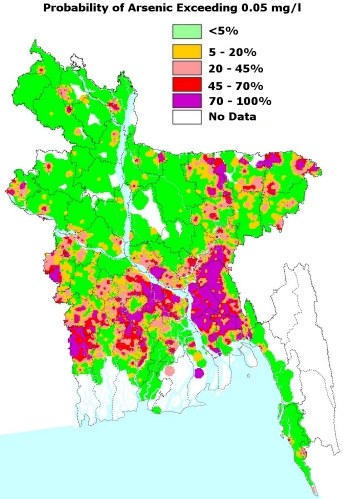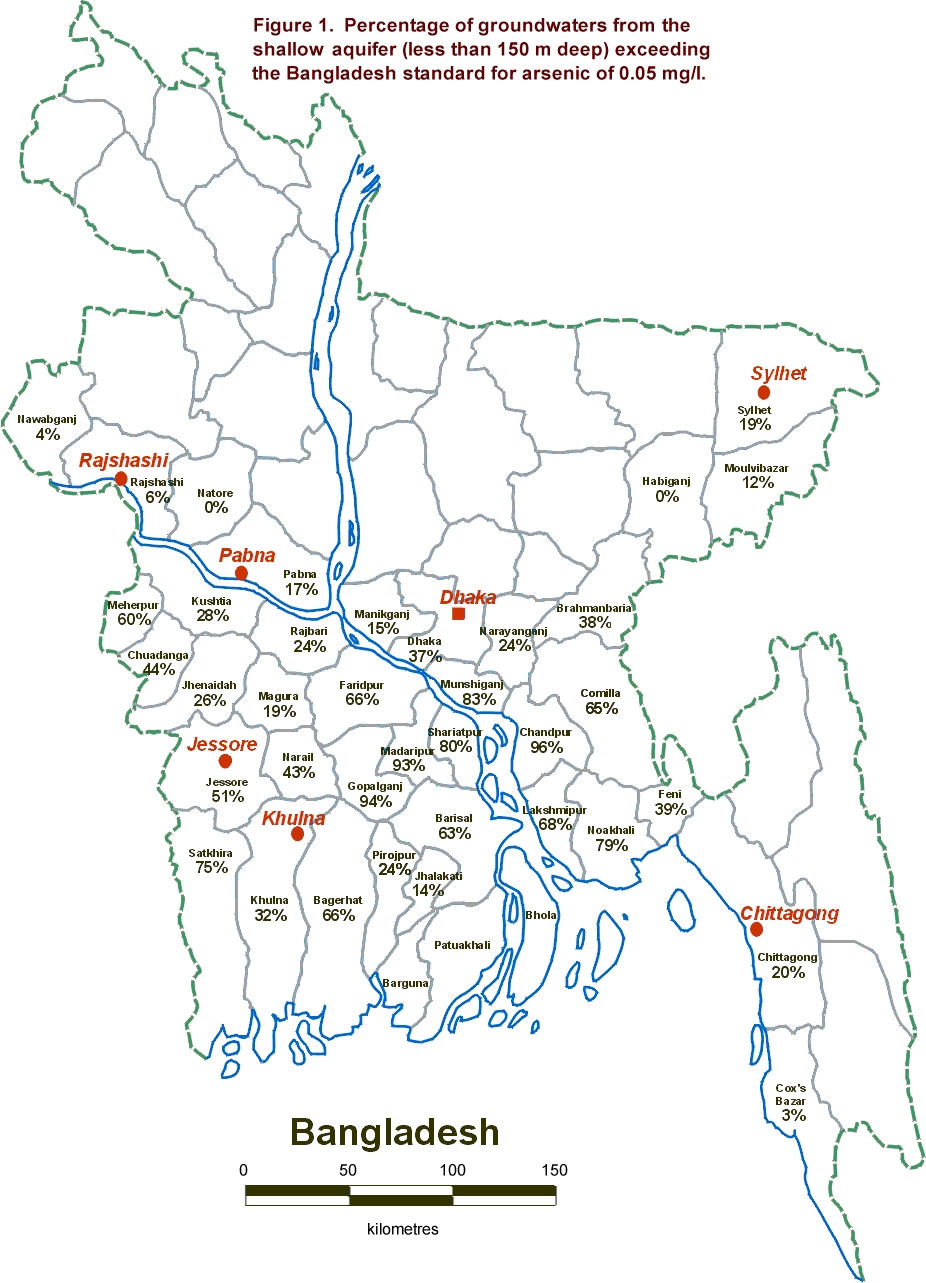Please View Sponsored Advertisements to Support this Site and Project
An Incorrect Arsenic Map of Bangladesh
Arsenic Concentration
Arsenic Contamination
Percentages of Shallow Well ContaminationMillions of dollar has been spent for a faulty map prepared by the British Geological Survey UK (BGS), Department of International Development UK and Department of Public Health and Engineering (Bangladesh). The same map has been interpreted or presented in different ways. Recent investigations show that many areas identified as arsenic free but contain 10 to 50 times higher arsenic than standard.
No uniform standard methods for collecting samples and analysis were applied for the determination of arsenic content. Recent verification in several rural areas of Bangladesh shows that areas shown to be arsenic free (less than 50µg/l) in the above map, in fact, contain dangerous level of arsenic in water
.For example, according to British Geological Survey/DPHE map in Faridpur district 34 percent of shallow tube wells are below 50 µg/l arsenic and coloured green. WHO (2000) proposed colour coding like “traffic lights”. It is paradox to say that cities existing traffic lights of Bangladesh do not function, and how can you expect in rural areas!!! You’ll find anywhere green or red coloured tube wells. We found many areas highly contaminated but are declared as arsenic free.
Impressive to see arsenic map of Bangladesh (BGR Homepage) - water flowing from the Himalayas to the Bay of Bengal, as if arsenic is carried from the Himalayas!
Possible Source of Arsenic Contamination Agrochemical?
UK based Water Aid and WS Atkins International declared (Arsenic 2000):
An emergency situation requires an emergency response - fast, effective, well-targeted action.
Three main areas for rapid response are:1. Grassroots and mass media campaigns to increase awareness on arsenic avoidance and best mitigation practices (in part being carried out by BAMWSP, DPHE, UNICEF, DANIDA and other actors but there is a need for clear, simple and consistent information to avoid confusion and / or panic within the community)
2. To increase the number of people with access to safe water, especially in hotspot villages (defined as villages with greater than 70% tube wells arsenic affected and at least one patient identified) and other highly affected areas. This would be done by the use of the Emergency Arsenic Task Force approach and the hotspot maps. Decisions on the safe water option should take into account the options listed in Annexe 8, the preliminary results from the DFID rapid assessment of household level arsenic removal technologies and the community preference. This approach would also find all arsenic 'hot spots' in the remaining districts using random survey, awareness campaigns, medics etc.
3. To increase the number of people with access to appropriate medical advice and treatment through an emergency programme.
But in practice the rural poor continues to suffer. No mitigation activities can be seen in the so-called “hot-spots”. Deep wells of Faridpur are arsenic contaminated (possibly due to conventional methods of drilling). The Water Supply (Dutch Aided) of Faridpur Water Supply disposes of arsenic sludge every day to Kumar River. Disposal of Arsenic sludge most possibly created these “Hot-Spots”.
The other alternative for groundwater supply is the development of deep tube wells (WHO, 2000). The British Geological Survey (1998) found only two out of 280 tube wells below 200 m in Bangladesh to be contaminated with high levels of arsenic. But most of these deep tube wells are located in the southern Bangladesh, which is separated by several meters of clay layers, which inhibit percolation of arsenic, contaminated water from the upper aquifers. Now many deep aquifers of Bangladesh have been contaminated through conventional method of drilling, use of cheap plastic pipes (pvc) and unprotected abandoned wells etc!
Recent Development in Bangladesh
British Geological survey under Fire
Editorial - the Bangladesh Observer
top of the page
Home


